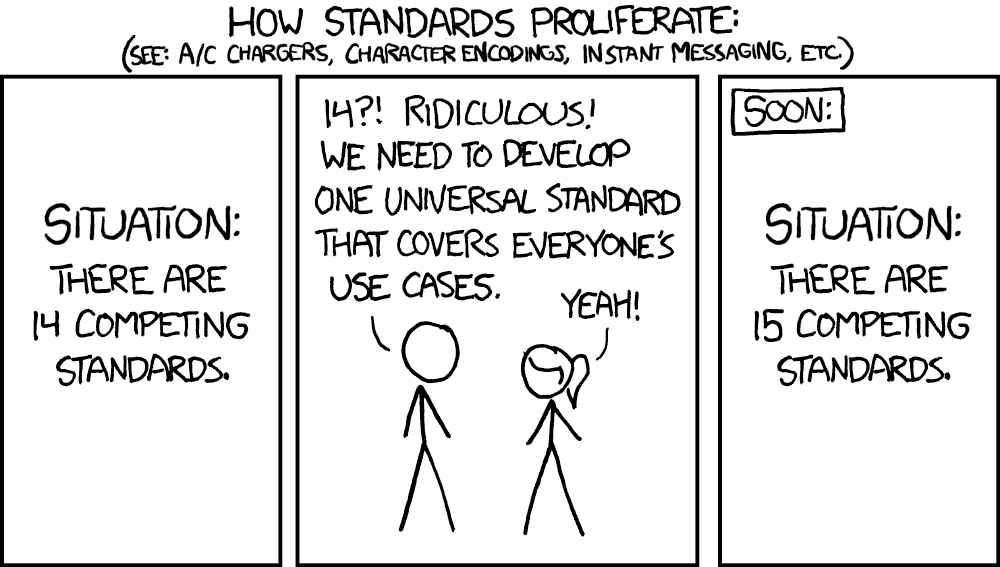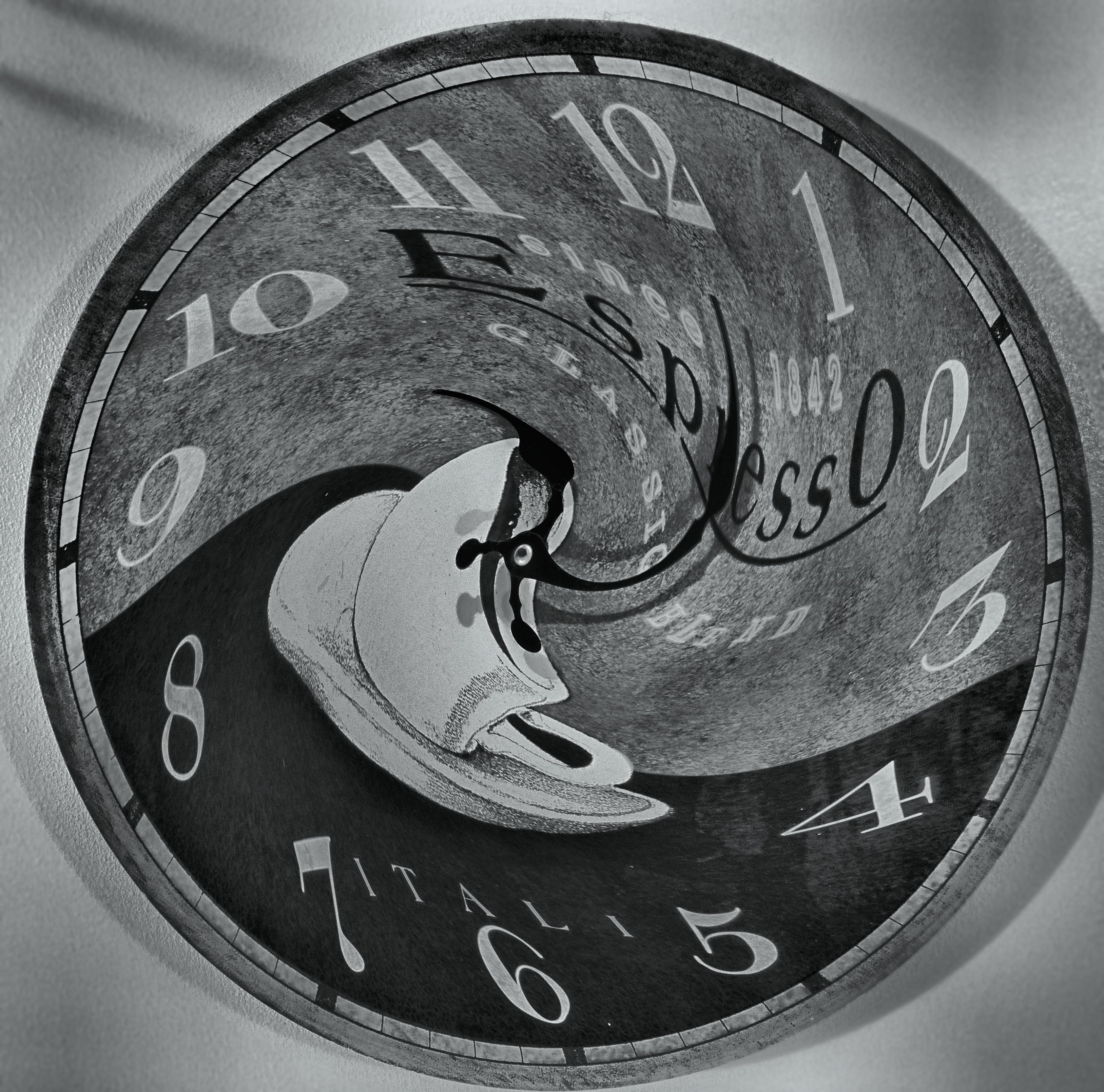Relevant XKCD

It’s less likely that than they don’t want to pay the HDMI license fee.
More likely they are worried that the US will limit the availability of HDMI and DP, like they tried with RISC-V, so they made their own.
Could be, though most of the “owners” are from Asian countries
With US orgs in their umbrellas so who knows what the orange wanker will do.
Please no.
Please bro, just one more standard bro, power delivery and high bandwidth data bro, it’s all we need bro please!
Just one more (data) lane, I promise brooooo
Big camera sensors use dozens of LVDS lanes without issue, and have you seen PCI express?
Which one?
Many of the larger Sony sensors for example. I can recall the IMX250 I think it was, from 10 years ago, had something like 48 LVDS pairs.
My bad, I was just making a joke.
Didn’t we already do this? I SWEAR we already did this.
Fuck. And we were finally down to just two standards…
Back to the days of S-Video, YPbPr Composite, Component, Scart, and RF, I suppose.
To be fair, scart was less of a standard for display, and more a pinout to carry most of that stuff. Scart is the least problematic of those in the list.
And largely the others weren’t so much competing as they addressed failures in those before it. RF had limited bandwidth and required a carrier. Composite was the same as RF, but better due to not needing the carrier. S-video is the same with the color information separated for a clearer image. Component is better still by further separating color signals.
The issue with HDMI and displayport is that they are largely the same thing.
Good point on Scart. DVI(-I/-D) would have been a better example than that.
I agree that each was an incremental improvement, but with how long it took for each of them to establish dominance and supersede the older standard, they might as well have been competing.
I still remember buying my kid a Wii, and you had a pick of composite, component, or S-Video. And that was nearly half a decade after HDMI was created…
The issue with HDMI and displayport is that they are largely the same thing.
Unfortunately, yeah. If it were up to me, though, HDMI would be phased out. With the exception of Audio Return Channel, DisplayPort can do everything consumer HDMI can do with higher bandwidth and without being encumbered by royalties.
If it were up to me, though, HDMI would be phased out.
I agree. But sadly, the media market has standardized on it so it’s here for a while. So for as long as there are TVs, we will have HDMI until they move to a new one.
I dunno man, hdmi has 400 different cable standards and then microhdmi on top.
Don’t forget miniHDMI!
To be “charitable” to HDMI, in its 23-year lifespan, it’s only seen 6 major and 4 minor revisions. The minor revisions are way too frequent, but at least the newer cables are compatible with devices using the older HDMI standard.
To be uncharitable to HDMI cable manufacturers, the shitty ones are causing major problems for consumers, exasperating the problem of HDMI being inconsistently functional:
-
The maximum length of an HDMI 2.0 cable is 50 feet before signal degradation starts to cause problems in high bandwidth applications. You can find 100ft “HDMI 2.0” cables all over Amazon, and I guarantee they won’t be able to do 4k120hz or 8k30hz without issues.
-
HDMI pin 18 is +5V power, which is barely ever used in cases where someone is connecting a source device directly to a sink device. Some manufacturers try to save on material costs by not including a wire for it and not mentioning that little omission. DisplayPort has the same issue. Guess what happens to devices when using a cable with the power pin connected and no protection for backfeeding? (Hint: an RMA. On that note, fuck Dell.)
-
Manufacturers selling cables without actually labeling the cable itself with the specification version. We all have a drawer of old HDMI cables, most of them won’t work for an 8K TV, and half of those you’ll only find out through trial and error.
I actually don’t have as much of an issue with the mini/micro variants of the connectors themselves. It’s pretty easy to find a passive adapter in most cases, and they mostly work fine as long as you aren’t trying to feed 4K over long distances or high refresh rates through them.
I didn’t come here to be educated! I’m here to be unreasonable!
-
HDMI is hot garage… still… so, anything to get us off it would be great
Displayport already exists and is way better and less expensive. The plug shape is also way better, and doesn’t have the annoying tendency to come slightly unplugged.
Now if only windows would stop reacting like I unplugged a DP monitor when it’s powered down.
Easy fix: Switch to Linux.
That is in the plans, although I’m not sure if it’s windows, the cable, or the monitor itself. Apparently DP standard doesn’t actually require the device to report itself being plugged in.
Always try the cheapest solution first when troubleshooting. Start with the cable, try the monitor on another system, etc.
it might also be a cable that doesn’t transmit power
“Only my opinions are valid and there can be no other use-cases!”
But seriously… this is the reason there are multiple standards, I think it’s quite obvious the situation is more complex than you think. If it was universally so easy and so much better, we’d all already be using it, but of course we are not.
If it was universally so easy and so much better, we’d all already be using it
This is not how the world works.
and why isn’t everything usb-c yet?
display port cables are cheaper than usb-c cables that support display port
oh i just meant for stuff like micro usb. really my only beef is with the idea that better standards just magically get universal acceptance and implementation.
We may actually need this in Europe. America gone full mad, so…
DisplayPort is royalty free, and VESA has many non-American companies in its membership list. Just saying.
Dang… Are you seeing this USB-C?
Dang, it’s almost like usb-c has half the conductors, way less precise tolerances, and ultimately has learned the most important thing they can do is be flexible (in both construction and standardization) and actually meet user needs. They obviously werent prepared for the unfathomable stupidity of people who can’t be expected to keep track of their cable capabilities, but they fixed that with new branding standards.
don’t be too arrogant and attribute it to stupidity. People have neither the time nor money to play whac-a-mole with the several thousand permutations of wattages, USB-C versions and port capabilities. Ignoring even quality inconsistencies with the same permutation of cable from the same manufacturer between two cables, it’s a nightmare.
Man, if only it was possible to know ahead of time what kind of standard the cable you want to buy supports. I wouldn’t be so annoyed if it wasn’t basically lottery, since they can put whatever wording they like on what’s basically a USB2.0 cable and have no repercussions whatsoever.
deleted by creator
“Darling can I take the TV cable? I need to charge the car”







